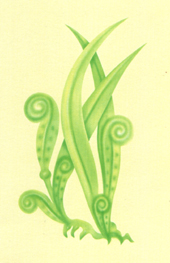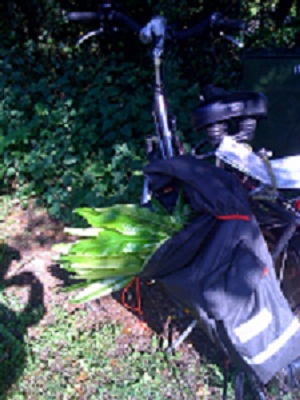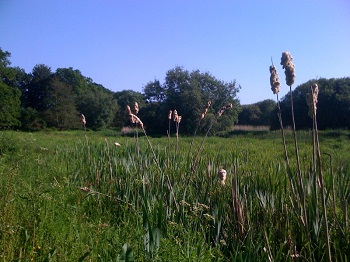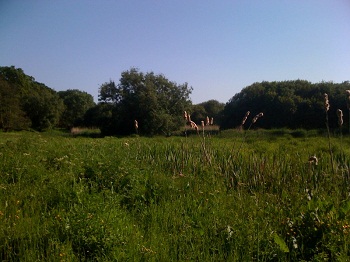Godshaer Fern and Clinic
Godshaer Name and History
This page relates to our Godshaer Clinic 1993-2011; it was renamed HERBACTIVE CLINIC IN 2011
Godshaer Fern
Godshær is a Anglo-Saxon term for the vegetation that covered the Earth. The medical practitioners of that time (who were steeped in “herball lore”) had great respect for the plants of the planet which they used both as food and as medicines: a gift from the living God. This veneration and “humble employment of herbes” that grew from the planetary orb (or head) was believed to be the hair or ‘haer’ of God, which the herbal physician would cut for use by his/her patients. Every year in every country there are harvest festivals celebrating and acknowledging our dependence on the growth and ripening of the fruits of the Earth, and each year we offer them to God with thanksgiving. Godshær is also a medicinal herb that has been used for hundreds of years (even Galen himself used it) and used even at the present time; its botanical name is Asplenium scolopendrium, also known as Hart’s Tongue. (full text below, see Dedication)
A Graceful Tale
In Devonshire children have a graceful tale about Harts-tongue fern.
It seems that the Son of Man was once in England and after much teaching and healing in the country where many had gathered to hear His new message, and when the the sun was going down, the Son of Man was tired and was in need of rest. He walked away by Himself to be alone to pray and sleep beside a stream in the shade of many trees. Around Him abounded the fresh soft fronds of the Hart’s Tongue herb. And so He prayed, kneeling on the soft herb. And afterwards He lay down beside the stream and used the Hart’s Tongue as His pillow. And so it was that Hart’s Tongue was once the pillow for the Son of Man, when he had nowhere to lay His head. In return for this service, He gave to the Hart’s Tongue two hairs from His most blessed and dear head, which the plant treasures in her ripe stem to this day, as His legacy – two auburn hairs which children find and show. So even today, you may take the stem and bend it and it will reveal the two hairs of God. From that day Hart’s Tongue was also called God’s Hair, or as it was spelt in the early days, God’s Haer, or Christ’s Hair.
– C. Marson in the preface to A. A. Hilton’s `In the Garden of God’ (London 1904), quoted in Roy Vickery’s `Dictionary of Plant Lore’ (Oxford University Press 1995) [adapted]
Guernsey’s Remarkable Name for this Plant
In Guernsey it has the remarkable name of Christ’s-hair. This name is explained by snapping the stipe and pulling out the solitary* black fibrovascular bundle. [Try it my good friend and you too will find this special gift of God’s haer.]* This reference to a solitary black hair is inaccurate; He left two not just one of the precious hairs from his head! (find out for yourself next time you go out into the country and walk along the bank of a stream where Godshaer grows) – ANH
– Edward Step `Wayside and Woodland Ferns’ (Frederick Warne 1945)
Asplenium scolopendrium (LINN.)
HART’S TONGUE, GODSHAER
Botanical: Scolopendrium vulgare; Asplenium scolopendrium (LINN.)
Family: N.O. Filices
Synonyms: Hind’s Tongue. Godshaer. Buttonhole. Horse Tongue. God’s-hair. Lingua cervina.
Part Used: Fronds.
The Hart’s Tongue, a fern of common growth in England in shady copses and on moist banks and walls, is the Lingua cervina of the old apothecaries, and its name refers to the shape of its fronds.
Description: Its broad, long, undivided dark-green fronds distinguish it from all other native ferns, and render it a conspicuous object in the situations where it abounds, as it grows in masses. It receives its name of Scolopendrium because its fructification is supposed to resemble the feet of Scolopendra, a genus of Mydrapods. The sori are in twin oblique lines, on each side of the midrib, covered by what looks like a single indusium, but really is two, one arranged partially over the other. In the early stages of its growth, the folding over of the indusium can be clearly seen through a lens. The fronds are stalked and the root, tufted, short and stout. This fern is evergreen and easy of cultivation.
Medicinal Action and Uses: In common with Maidenhair, this fern was formerly considered one of the five great capillary herbs. It has been called England’s Ginkgo.
The older physicians esteemed it a very valuable medicine, and Galen gave it in infusion for diarrhoea and dysentery, for which its astringent quality made it a useful remedy. In country districts, especially in Wales and the Highlands, an ointment is made of its fronds for burns and scalds and for piles, and it has been taken internally for Bright’s Disease, in a decoction made of 2 oz. to a pint of water, in wineglassful doses. In homoeopathy, it is administered in combination with Golden Seal, for diabetes. It is specially recommended for removing obstructions from the liver and spleen, also for removing gravelly deposits in the bladder. Modern uses show it is helpful for memory, stroke and blood pressure.
Culpepper tells us:
‘It is a good remedy for the liver, both to strengthen it when weak and ease it when afflicted…. It is commended for hardness and stoppings of the spleen and liver, and the heat of the stomach. The distilled water is very good against the passion of the heart, to stay hiccough, to help the falling of the palate and to stay bleeding of the gums by gargling with it.’~}
A Modern Herbal by Mrs M Grieve
Also known as Scolopendrium vulgare and Phyllitis scolopendrium.
This is a hardy perennial.
Cultivation. Plant during April in shade in a humus-rich preferably limy soil.
The best position for indoor plants in a shady window. Pot in 4-6 inch pots containing well-drained compost of equal parts (by volume) loam, leaf-mould or peat, and coarse sand. Water freely during the growing season, at other times just sufficiently to keep the soul moist. Shade is essential for all species.
Description from The Complete Herbal by Nicholas Culpeper (1820 edition):
Hart’s-Tongue. This has divers leaves arising from the root, every one severally, which fold themselves in their first springing and spreading: when they are full grown, are about a foot long, smooth and green above but hard and with little sap in them, and streaked on the back, athwart on both sides of the middle rib, with small and somewhat long and brownish marks; the bottoms of the leaves are a little bowed on each side of the middle rib, somewhat small at the end. The root is of many black threads, folded or interlaced together.
It is green all the winter; but new leaves spring every year.
Jupiter claims dominion over this herb, therefore it is a singular remedy for the liver, both to strengthen it when weak, and ease it when afflicted, you shall do well to keep it in a syrup all the year; For though authors say it is green all the year, I scarcely believe it [Culpeper is wrong here, and obviously had never seen the plant in winter – it does indeed stay green all year. ANH]. Hart’s Tongue is much commended against the liver, and against the heat of the liver and stomach, and against lasks, and the bloody-flux. The distilled water thereof is also very good against the passions of the heart, and to stay the hiccough, to help the falling of the palate, and to stay the bleeding of the gums, being gargled in the mouth. Dioscorides saith, it is good against the stinging or biting of serpents. As for the use of it, my direction at the latter end will be sufficient, and enough for those that are studious in physic, to whet their brains upon for one year or two.
The Green Knight
In Sir Gawain, the Green Knight is so called because his skin is in fact green. The meaning of his greenness has puzzled scholars since the discovery of the poem, ranging from views that he is some version of the Green Man, a vegetation being in medieval art, to a recollection of a figure from Celtic mythology, to a Christian symbol, to the Devil himself. J. R. R. Tolkien called him the “most difficult character” to interpret in the introduction to his edition of Sir Gawain and the Green Knight. His major role in Arthurian literature includes being a judge and tester of knights, and as such the other characters see him as friendly but terrifying and somewhat mysterious.
The Old Stables – Modern Clinic of Herbal Medicine[Godshaer and the Old Stables in Christchurch are uniquely bonded by our long-time patients and customers due to the fact that we were there for over 15 years. Godshaer Clinic moved in 2008 to Lymington, close to the New Forest Hospital. It was renamed Herbactive Clinic when it moved to New Milton in 2011.]The Old Stables is where pilgrims used to water, feed and stable their horses, before going across to the Priory Church to pray and perhaps take a splinter from the Miraculous Beam. Miracles, especially healings linked to eye problems, were not unknown at the Priory (over 900 years old). The healing water of Tutton’s Well, a natural spring, in Stanpit, a mile from the Christchurch Priory, was also used for sight ailments since Roman times, and was probably the water “of uncommon purity” used in the Priory for both its healings and in the sacred Cup. Hence, Christchurch acquired a reputation as a centre of learning, healing and caring, where miracles often occurred; an ancient centre where one’s inner perceptions, visions and enlightenment (seeing the Light of the Self) could be experienced and maintained.
It appears that early last century the Christchurch Health Officer lived at Coachman’s Cottage near the Old Stables. He refused to buy a carriage preferring to visit his patients on horseback. He kept his horse in the Old Stables.
At Godshær Herbalist Clinic, housed in the Old Stables, we are continuing the good tradition of working with the natural healing energies both in the human being and in the plants (the hair) of the Earth Being. We are dedicated to the service of the Christchurch community with the natural medicine and healing which is both safe and effective.
You are invited to visit Godshaer or make an appointment with our herbalist.
Godshaer and the Old Stables in Christchurch are uniquely bonded by our long-time patients and customers due to the fact that we were there for over 15 years. Godshaer Clinic moved in 2008 to Lymington, close to the New Forest Hospital.
The Godshaer herb can be seen growing ouside the clinic, originally collected at the Wey Spring, where the spring water was first drawn for our organic tinctures.
Godshaer - ABC of Medicine
Godshær – Advanced Botanical Centre of Medicine, long established in Christchurch and Bournemouth, moved to the centre of Christchurch in 1993 in sight of the 900 year old Priory Church and has become the largest and busiest herbalist shop-clinic in the south of England. The Old Stables, in a conservation area, has been transformed to serve Herbalism and Complementary Medicine. A large dispensary has been purpose-built to prepare and extract flowers and fruits, roots and rhizomes, leaves, seeds, barks and oils for patients’ personal prescriptions. Under the direction of Alan Hopking, who is a member of the oldest professional organisation of herbal practitioners in the world, the National Institute of Medical Herbalists, the medicinal herbs are carefully and respectfully extracted and prepared. The tinctures made according the British Herbal Pharmacopoeia uses the pure spring water from the Wey Spring, collected by Alan himself (helped at times by Mez his son)! [Tutton’s Well water can’t be used as it was capped in 1940. It is hoped it will be reopened. Latest news: Tutton’s Well has been reopened in 2002 and is also used in Alan’s tinctures.] Consulting Mr Hopking will require an hour for your first visit. The medicine will be ‘tailor made’ for you. Normally, after two weeks he will see you again (for half an hour). The medicine will probably be adjusted according to the changes that have occurred. Follow-ups will then be arranged depending on the nature of the problem. Telephone, with no obligation, for more information, or come to our Free Advice Clinic. See below. Consultation options, click here.
For those weary of ill health
For those weary of ill health and alarmed by the reported side-effects of many modern drugs, a consultation can be the turning point which will lead to a regeneration of well-being. Here can be found a sympathetic and skilled practitioner, willing to give the patient time, care and natural remedies, which offer a gentle yet effective way back to health.
You are welcome to visit our little shop of non-prescription tonics, ointments, creams, liniments, lotions, cough syrups, mixtures, formulas, washes, oils, and teas. There are also books for sale, a range of vitamins and minerals. Hop along to the herb king! Now you can visit our online store with over 500 herbal products order and receive it the next day.
Godshaer long established in Christchurch moved in 2008 to Lymington, close to the New Forest Hospital. Then, in 2011, we moved again, to open a herbal shop HERBACTIVE in the beautiful old town of New Milton close to magnificent cliffs and beaches and the beauty of the ancient New Forest National Park (Milton has over 1000 years of history – Milton became New Milton when the railway station was built here in 1888).
There has been no change of our business ownership: we are both Godshaer as a web name only now, and Herbactive as a Herbal Clinic and Shop on the high street (Station Road) of New Milton. HERBACTIVE Ltd became a limited company on May 31st 2013; Alan Hopking is the Director.
From HERBACTIVE follow Station Road south for 2 miles and you reach those amazing seaside cliffs and beaches with paths to walk or cycle; or drive north from HERBACTIVE for just 2 miles past Ballard Lake and meadow on Fernhill Road and you’ll enter the famous New Forest (created as a royal forest by William I in about 1079 for the royal hunt, mainly of deer, and where two of Wiliam’s sons were killed, Prince Richard in 1081 and King Rufus in 1100).
New Milton is situated between Bournemouth to the west and Southampton to the east, and Salisbury to the north and Yarmouth (Isle of Wight) to the south.
After your consultation at HERBACTIVE, enjoy your visit to the area, you’ll be made to feel at home here.
————–
Read the following dedication as found inside the Clinic:
Dedication
GODSHÆR is an Anglo-Saxon word for the vegetation growing upon the world. It was believed to be the hair or ‘haer’ of the Great Goddess, the living Earth, which was known to contain magical powers. In those days the medical practitioners, who were steeped in ‘herball lore’, would cut the ‘haer’ at the right time to extract the elixir of the Goddess for their patients’ healing. This links the ancient folk tradition shared by the Green man and the Great goddess representing in human form the archetype of nature and health and inspiration; they can be seen in sacred sculptures down the ages, and in churches and cathedrals. They depict the human head formed out of a leafy mask with hair of leaves and herbs (Godshær). There is an interesting example in our Christchurch Priory, itself a centre of pilgrimage famed for its Miraculous Beam with its reputation of healing and caring.
To select the ‘haer’ correctly, our herbalist ancestors had to hear the call to go into the countryside (then called “greenmans”), look up into the eyes of God and take counsel from the Green Man who “knows and utters the secrets of nature” (hence the vine issuing from his mouth). In this way wise medical doctors down the centuries who listened to the Green Man and to the Great Goddess have provided us with an excellent green pharmacy. Modern herbalists of all cultures continue this tradition encouraged by the World Health Organisation.
Even today, in every country there are annual harvest festivals celebrating and acknowledging our dependence on the growth and ripening of the fruits of the Earth, and each year we offer them to God with thanksgiving.
Godshær Herbalist was founded under the triangle ‘eyes’ of the Bull, the Twins and the Virgin.
Godshær is also the name of a medicinal plant (Asplenium scolopendrium), common, and native to England. It can be seen in shady copses, in woods and by the side of streams. Its fronds are long, undivided, tapering to a point, with a heart-shaped base. It is green all the winter; new leaves spring every year. Jupiter claims dominion over this fern, making it a singular remedy for the healthy liver. Godshær is also one of the five great capillary herbs. Physicians down the ages have esteemed Godshær a very valuable medicine for removing obstruction, healing, soothing and strengthening the higher and lower organs, through its vitalising action on the spleen.
Using medicinal plants is natural and safe under the trained practitioner, who listens…………
…The tradition continues…
————–
Asplenium scolopendrium
Common Names: Godshaer, Christ’s-hair, God’s-hair, Hart’s-tongue, Hind’s Tongue, Buttonhole, Horse Tongue, Lingua cervina.
You can buy this herbal extract made as a wild-crafted fresh tincture. To order click here
Buy any of our 400 herbal tinctures or over 121 Tonics at our online store









